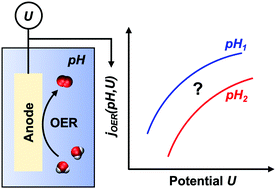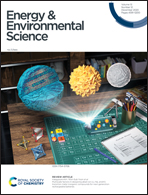Microkinetic model for pH- and potential-dependent oxygen evolution during water splitting on Fe-doped β-NiOOH†
Abstract
Electrochemical water splitting using excess renewable electricity is a CO2-free synthesis route for sustainable hydrogen production and a renewable-energy storage strategy. Electrolyte pH and electrode potential are key reactor operating conditions used to tune water-splitting kinetics whose influence remains incompletely understood. Here, we develop a microkinetic model, based on the Marcus theory of electron transfer, to predict the anodic oxygen-evolution-reaction (OER) current density (water-splitting rate) as a function of solution pH and electrode potential. Our model offers startling new insights into OER kinetics on Fe-doped β-nickel oxyhydroxide (β-NiOOH), a promising, inexpensive candidate for electrocatalyzing the OER, under alkaline solution conditions. Only four fitting parameters with clearly defined physical meaning – reorganization free energies (λ) for H+- and OH−-based reactions and work terms (w) for transporting H+/OH− ions and water from the bulk solution to the electrocatalyst surface – are required to reproduce experimental polarization curves (i.e., current-density vs. potential plots) at multiple alkaline pHs. The inclusion of work terms renders multiple steps rate-determining for the OER. The predicted λH+ = 0.744 eV is much smaller than λOH− = 2.474 eV, and wions = 0.607 eV is much larger than wwater = 0.065 eV, suggesting that the OER occurs primarily but not exclusively via water oxidation, rather than hydroxide oxidation, even under alkaline conditions. We show unequivocally that hydroxide oxidation also must occur as a minor channel, as accurate reproduction of polarization curves is impossible without it. We conclusively demonstrate the need to use the reversible, rather than the standard, hydrogen electrode as a reference in microkinetic models. Moreover, we deduce that the electrocatalyst surface is positively charged, contrary to inferences made in previous reports. Finally, we predict the following properties for the OER under high overpotential (≳0.3 V) conditions on Fe-doped β-NiOOH: a Tafel slope of ∼76 mV per decade, an effective charge transfer coefficient of 0.77, and an exchange current density of 3.5 μA cm−2 rivaling that of RuO2, one of the best noble-metal-containing water-splitting electrocatalysts. Our work substantially deepens the mechanistic understanding of water-splitting kinetics on inexpensive iron/nickel-oxyhydroxide-based electrocatalysts, which may help optimize operating conditions for their widespread deployment.



 Please wait while we load your content...
Please wait while we load your content...
